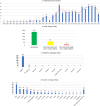What We Do Not Know About Stretching in Healthy Athletes: A Scoping Review with Evidence Gap Map from 300 Trials
- PMID: 38457105
- PMCID: PMC11239752
- DOI: 10.1007/s40279-024-02002-7
What We Do Not Know About Stretching in Healthy Athletes: A Scoping Review with Evidence Gap Map from 300 Trials
Abstract
Background: Stretching has garnered significant attention in sports sciences, resulting in numerous studies. However, there is no comprehensive overview on investigation of stretching in healthy athletes.
Objectives: To perform a systematic scoping review with an evidence gap map of stretching studies in healthy athletes, identify current gaps in the literature, and provide stakeholders with priorities for future research.
Methods: Preferred Reporting Items for Systematic Reviews and Meta-Analyses (PRISMA) 2020 and PRISMA-ScR guidelines were followed. We included studies comprising healthy athletes exposed to acute and/or chronic stretching interventions. Six databases were searched (CINAHL, EMBASE, PubMed, Scopus, SPORTDiscus, and Web of Science) until 1 January 2023. The relevant data were narratively synthesized; quantitative data summaries were provided for key data items. An evidence gap map was developed to offer an overview of the existing research and relevant gaps.
Results: Of ~ 220,000 screened records, we included 300 trials involving 7080 athletes [mostly males (~ 65% versus ~ 20% female, and ~ 15% unreported) under 36 years of age; tiers 2 and 3 of the Participant Classification Framework] across 43 sports. Sports requiring extreme range of motion (e.g., gymnastics) were underrepresented. Most trials assessed the acute effects of stretching, with chronic effects being scrutinized in less than 20% of trials. Chronic interventions averaged 7.4 ± 5.1 weeks and never exceeded 6 months. Most trials (~ 85%) implemented stretching within the warm-up, with other application timings (e.g., post-exercise) being under-researched. Most trials examined static active stretching (62.3%), followed by dynamic stretching (38.3%) and proprioceptive neuromuscular facilitation (PNF) stretching (12.0%), with scarce research on alternative methods (e.g., ballistic stretching). Comparators were mostly limited to passive controls, with ~ 25% of trials including active controls (e.g., strength training). The lower limbs were primarily targeted by interventions (~ 75%). Reporting of dose was heterogeneous in style (e.g., 10 repetitions versus 10 s for dynamic stretching) and completeness of information (i.e., with disparities in the comprehensiveness of the provided information). Most trials (~ 90%) reported performance-related outcomes (mainly strength/power and range of motion); sport-specific outcomes were collected in less than 15% of trials. Biomechanical, physiological, and neural/psychological outcomes were assessed sparsely and heterogeneously; only five trials investigated injury-related outcomes.
Conclusions: There is room for improvement, with many areas of research on stretching being underexplored and others currently too heterogeneous for reliable comparisons between studies. There is limited representation of elite-level athletes (~ 5% tier 4 and no tier 5) and underpowered sample sizes (≤ 20 participants). Research was biased toward adult male athletes of sports not requiring extreme ranges of motion, and mostly assessed the acute effects of static active stretching and dynamic stretching during the warm-up. Dose-response relationships remain largely underexplored. Outcomes were mostly limited to general performance testing. Injury prevention and other effects of stretching remain poorly investigated. These relevant research gaps should be prioritized by funding policies.
Registration: OSF project ( https://osf.io/6auyj/ ) and registration ( https://osf.io/gu8ya ).
© 2024. The Author(s).
Conflict of interest statement
The authors have no competing interests.
Figures








References
-
- ACSM. ACSM’s Guidelines for Exercise Testing and Prescription. 10th ed. Wolters Kluwer; 2018.
-
- Association AH: Guidelines and statements. 2020. https://professional.heart.org/en/guidelines-and-statements/guidelines-a.... Accessed 25/10/2020.
-
- Behm DG. The science and physiology of flexibility and stretching. Implications and applications in sport performance and health. Oxon: Routledge; 2019.
Publication types
MeSH terms
LinkOut - more resources
Full Text Sources
Miscellaneous

